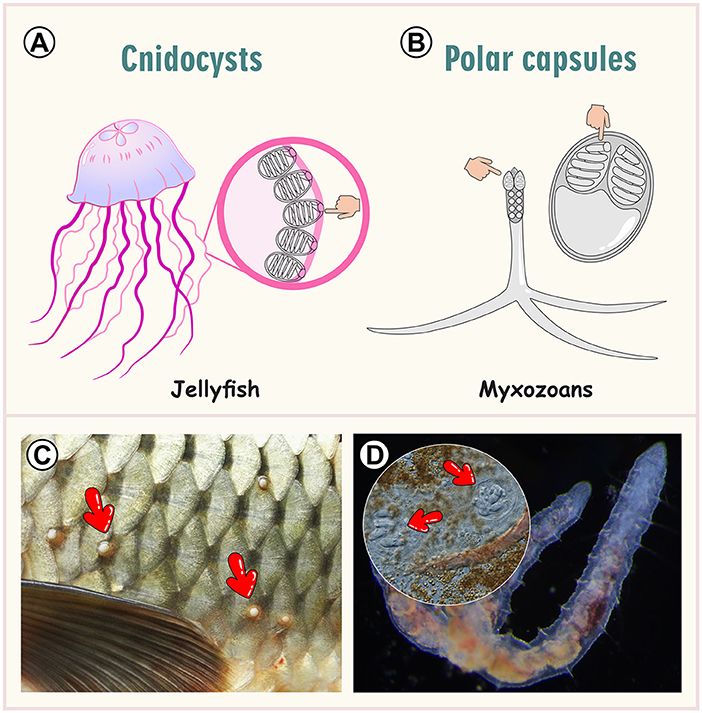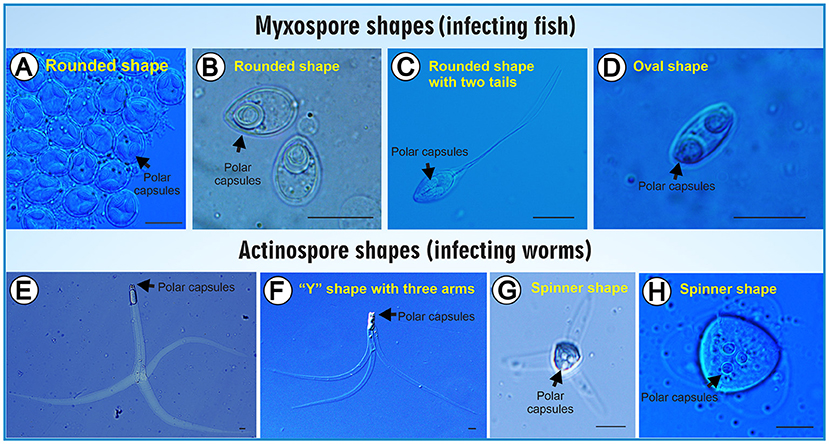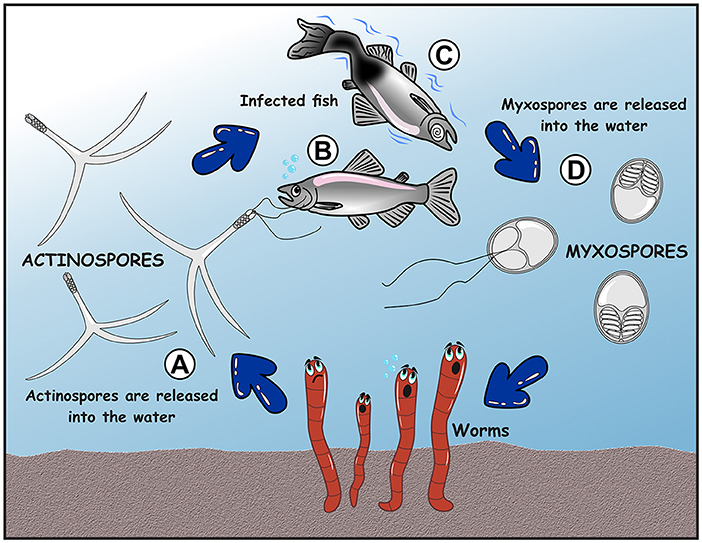Abstract
Parasites are everywhere, living among us. Some well-known parasites include ticks, fleas, and mites. However, Myxozoans are a lesser-known type of parasite, with a name made up of two Greek words: “myxa” means “slime” or “mucus”, and “zoon” means “animal”. Myxozoans are related to jellyfish, corals, sea anemones, and hydras. Myxozoans infect animals living in aquatic ecosystems worldwide, and they can only survive and reproduce by living off those animals (called hosts)—not on their own. Myxozoans need two hosts during their life cycle. In each host, Myxozoans can change shape and look almost completely different. They also use unique strategies like releasing threads to attach and infect fish. In this article, among other interesting facts, you will discover how Myxozoans cause some of the most dangerous fish diseases, and whether they pose a risk to humans.
Parasites Everywhere
Have you ever thought about what parasites are and where they come from? Well, researchers have suggested that parasites originally evolved from non-parasitic organisms. The difference between non-parasites and parasites is that parasitic organisms benefit at the expense of another organism, called the host. Parasites live on or in the host, feeding, growing, or reproducing in ways that harm the host’s body. The parasitic lifestyle is so successful that it has lasted for billions of years, and nature has plenty of examples. You are probably familiar with ticks, fleas, and mites, for instance. Parasites multiply easily and quickly because every host is a rich source of nutrients and energy. We can find parasites in every living organism, including humans, pets, aquatic animals, plants, insects, reptiles, birds, and more.
Cnidarians are a group of mostly non-parasitic aquatic invertebrates, such as jellyfish, corals, sea anemones, and hydras. However, these aquatic creatures have some siblings that live as parasites: the Myxozoans. About 600 million years ago, Myxozoans changed from a free-living (non-parasitic) to a parasitic lifestyle. On their way to becoming parasites, the structure of Myxozoans has simplified, but they have retained some features common to all cnidarians, including strategic tools like capsules. Capsules look like eggs and contain long, thin, coiled strings or hollow threads with spiky barbs on them (Figure 1). In jellyfish, corals, and sea anemones, these capsules are called cnidocytes. Cnidocytes are located near the tips of the tentacles and are used as stinging weapons to inject venom into prey or defend against predators. In Myxozoans, the so-called polar capsules (Figure 1B) eject a thread that helps them attach to the host—attachment is the first step in infection.

- Figure 1 - (A) A jellyfish has tentacles armed with tiny capsules called cnidocytes to attack prey and defend against predators.
- (B) Two types of Myxozoan spores with tiny polar capsules that help them attach to and infect their hosts. (C) This fish has many plasmodia on its scales (red arrows). (D) A worm observed with a microscope, showing plasmodia inside of it (red arrows).
Myxozoans mainly infect fish and worms (Figure 1). They are of greater importance in fish, as they can cause serious damage and lead to a variety of health problems [1]. Myxozoans are so tiny that it is impossible to see them with the naked eye. We can notice them in infected fish because they grow inside a small, rounded sac called a plasmodium. The plasmodium is typically whitish or creamy in color, containing thousands of spores, and can be as large as 2 cm (Figure 1C). To see plasmodium inside the worms always requires a microscope because these plasmodia are only around 0.006 cm (Figure 1D).
How do Myxozoan Parasites Live?
Throughout their lives, Myxozoans have two spore shapes that look entirely different: the myxospores and the actinospores. These differences are so significant that, for decades, researchers thought they were different types of parasites. Today we know both types of spores come from the same parasite, and that each one develops in a different host. Myxospores are usually more circular, rounded, ellipsoidal or oval. Actinospores can have various stunning shapes, mainly triangular “spinner” or Y-shaped structures (Figure 2).

- Figure 2 - Myxospores and actinospores have different shapes.
- (A, B) Myxospores with a rounded shape. (C) An oval Myxospore with two tails. (D) A Myxospore with an oval shape. (E, F) Actinospore have a main body with three “arms” coming off it. (G, H) Actinospores with three appendages, resembling a spinner. The black bars in each photo indicate a measurement of 0.001 cm.
The life cycle of Myxozoans begins when the actinospores are released by worms that live in the sediment at the bottom of waterbodies (Figure 3A). The actinospores float around until they find a fish. When they find the right host, they shoot the polar filament barbs from their polar capsules and anchor into the fish’s gills or skin (Figure 3B). Once they attach themselves to the fish, they penetrate into the fish’s body until they find the blood system. Then, they circulate throughout the blood to reach the fins, muscles, kidneys, liver, spleen, heart, intestines, and brain—the organs where the parasites develop. This can damage the fish, resulting in disease (Figure 3C). When the spores grow up, they are released from infected fish through their pee and poop. Other times, an infected fish dies, and the worms eat their sunken carcass and get infected that way. The myxospores travel through the worm’s digestive system and start producing actinospores. Later, the actinospores are released to infect more fish, keeping the life cycle going (Figure 3D) [2, 3].

- Figure 3 - The life cycle of Myxozoans requires two hosts: fish and worms.
- (A) When an infected worm releases actinospores into the water, the parasites float until they find the fish host. (B) The actinospore penetrates through the skin using its strings and travels to the target organs. (C) As the actinospores transform into myxospores, they grow, feed, and multiply in the host, which makes the fish sick. (D) The myxospores are released into the water, where they find new worms to infect.
Myxozoans can Change Fish Behavior
Aquatic ecosystems are full of Myxozoans, but only a small percentage cause terrible diseases in their hosts. A fascinating example is whirling disease, caused by a type of Myxozoans called Myxobolus cerebralis. This parasite was first found infecting the brains of salmon, hence the name cerebralis—a word derived from the Latin “cerebrum”, meaning brain. Myxozoans invade the skull and spinal column in the fish, causing body deformities, darkening of the tails, and damage to the nerves and brain (Figures 3B, C). When brain damage occurs, fish lose control over their movements and begin to swim in erratic patterns, appearing to chase their tails. This weird swimming behavior, together with a dark tail, makes it easy to spot infected fish (Figure 3C). When fish swim in a whirling way for long periods, they can become tired and stressed. The loss of energy makes it hard to find food, which can lead to starvation and even death. Up to nine out of 10 infected fish die. The dead fish become food for worms, which then become infected, and the life cycle of Myxozoans is repeated over and over again (Figure 3) [4].
Kidney Disease
The Myxozoan called Tetracapsuloides gets its name from the fact that it has four polar capsules (“tetra” means four), and it causes kidney disease in fish. Tetracapsuloides attacks the kidneys of freshwater salmon, but develops in tiny organisms called bryozoans rather than worms. Kidneys are critical organs that filter waste products from the blood, such as old or damaged cells. The parasites invade the host’s kidneys, which become swollen and spotty gray in color, with bulging ridges. The damaged kidneys fail and the fish cannot eliminate waste products, which build up and become toxic, damaging other important organs. The disease is also associated with a decrease in oxygen-carrying red blood cells, so the organs do not receive enough blood, resulting in the pale color of the gills and the heart. Tetracapsuloides infection kills many of the European and North American salmon that it infects. Nowadays, this emerging disease is decreasing salmon populations in their natural environments [3].
Myxozoan Parasites and Global Warming
Some Myxozoan parasites damage the important fish that feed millions of humans worldwide. Fish are vital to the human diet, so there has been a massive increase in fish farming, or aquaculture, in the last two decades. However, the increase in Earth’s temperature due to global warming is becoming a serious problem for the health and welfare of all living beings, including fish. But how can global warming affect Myxozoan diseases in fish? Scientists have discovered that warmer temperatures help Myxozoan diseases to spread and make outbreaks more severe. For example, kidney diseases in salmon increased when the water temperature exceeded 12–14°C (53.6–57.2°F). This is important because when water is warmer than usual, more fish get sick and die. This is why more research on fish parasites is happening—to avoid the deaths of large numbers of fish and the associated loss of money for fisherman and fish farmers. Myxozoan diseases are challenging to control because there are no effective drugs or vaccines. Only one medicine is available, called fumagillin, but its excessive usage causes tissue damage and slows fish growth. So, prevention is still the best choice [5].
But what can be done to prevent Myxozoan diseases? Controlling the water temperature in tanks where fish are farmed, as well as cleaning the tanks to avoid the buildup of poop and fish food waste can be helpful actions. If you have a pet fish and can no longer care for it, do not just put it into a river or lake. This could introduce a new type of Myxozoan, which could cause harmful diseases and even the extinction of native fish. It is better and more pet-friendly to find a new family to take care of your fish if you cannot.
Can Myxozoans Make People Sick?
Myxozoans are considered harmless to humans, but a few species have been associated with food poisoning, including symptoms like diarrhea, fever, and vomiting. These parasites have been detected in the intestines of people who eat raw fish in Japan, Korea, Australia, Canada, and Colombia. In some cases, Myxozoans have also been found in poop samples taken from apparently healthy individuals. To date, no strong evidence exists that any Myxozoans are particularly dangerous for human health [5]. However, animals including amphibians, turtles, waterfowl, and small terrestrial mammals like moles and shrews can serve as hosts for some Myxozoans. The fascinating lifestyle of the Myxozoans has motivated many research teams worldwide to learn as much as possible about them, understand their impact on animals and ecosystems, and estimate the possibility of human diseases. Every day, parasite researchers work hard to understand every step in their life cycle and find the best ways to stop them from making fish sick. The big goal is to keep the welfare and health of fish populations healthy in the wild and on fish farms. So, the more we understand about Myxozoans, the better we can care for fish, and maybe even ourselves.
Glossary
Host: ↑ A living being that provides shelter and food for other organisms, and lives off them.
Cnidocytes: ↑ Specialized cells that can shoot a thread to attach to living organisms.
Polar Capsules: ↑ A structure that myxozoans have and contain an ejector thread. This is used to attach and infect their host.
Plasmodium: ↑ A cysts that enclosed thousands of spores.
Spores: ↑ In the world of Myxozoans, it is the infection stage of the parasite, which can have two types, Myxospore and Actinospore.
Myxospores: ↑ A type of spore shape that myxozoans that occur within the fish.
Actinospores: ↑ A type of spore shape that myxozoans that occur within the worms.
Bryozoans: ↑ Small aquatic invertebrates, also called moss animals that live in colonies. They have a peculiar feeding structure called a lophophore, which resembles a “crown” of tentacles used for filter feeding.
Conflict of Interest
The authors declare that the research was conducted in the absence of any commercial or financial relationships that could be construed as a potential conflict of interest.
Acknowledgments
The author(s) declare that financial support was received for the research and/or publication of this article. The PhD studies of GEC-R are supported by SECIHTI, Mexico (grant number: CVU 769732) and the Stipendium Hungaricum Program.
AI Tool Statement
The author(s) declare that Gen AI was used in the creation of this manuscript. During the preparation of this manuscript, the author(s) used Grammarly to check grammar, spelling, and the readability of captions. After using this tool, the author(s) thoroughly reviewed and edited the content as needed and take full responsibility for the accuracy of the article. Any alternative text (alt text) provided alongside figures in this article has been generated by Frontiers with the support of artificial intelligence and reasonable efforts have been made to ensure accuracy, including review by the authors wherever possible. If you identify any issues, please contact us.
References
[1] ↑ Atkinson, S. D. and Bartholomew, J. L,Lotan, T. 2018. Myxozoans: ancient metazoan parasites find a home in phylum Cnidaria. Zoology. 129:66–8. doi: 10.1016/j.zool.2018.06.005
[2] ↑ El-Matbouli, M., Hoffmann, R. W, Schoel, H., McDowell, T.S., and Hedrick, R. P. 1999. Whirling disease: host specificity and interaction between the actinosporean stage of Myxobolus cerebralis and rainbow trout Oncorhynchus mykiss. Dis. Aquat. Organ. 35:1–12. doi: 10.3354/dao035001
[3] ↑ Sudhagar, A., Kumar, G., and El-Matbouli, M. 2019. The Malacosporean Myxozoan parasite Tetracapsuloides bryosalmonae: a threat to wild salmonids. Pathogens. 9:16. doi: 10.3390/pathogens9010016
[4] ↑ Okamura, B., Gruhl, A., and Bartholomew, J. L. 2015. Myxozoan Evolution, Ecology and Development. Cham: Springer International Publishing. doi: 10.1007/978-3-319-14753-6
[5] ↑ Banu, H. and Rathinam, R. B. 2023. Myxozoan fish diseases: possible treatment and zoonoses. J. Parasit. Dis. 47:215–23. doi: 10.1007/s12639-023-01568-9
